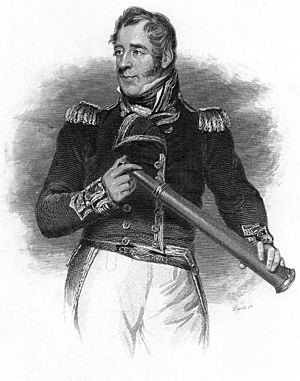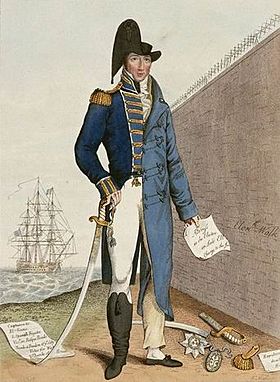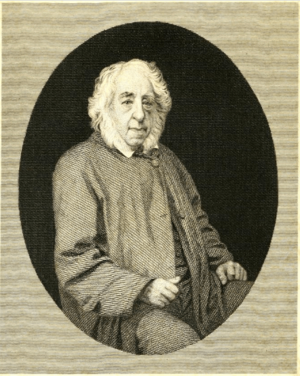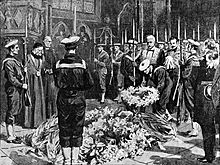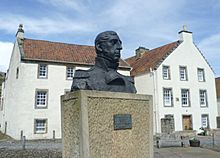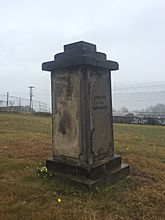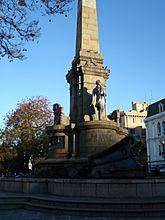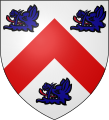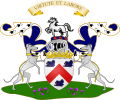Thomas Cochrane, 10th Earl of Dundonald facts for kids
Quick facts for kids
The Earl of Dundonald
|
|
|---|---|
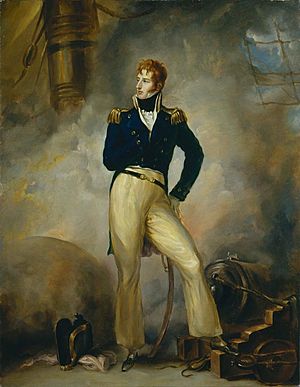 |
|
| Member of Parliament for Honiton |
|
| In office 1806–1807 |
|
| Preceded by | Richard Bateman-Robson |
| Succeeded by | Sir Charles Hamilton |
| Member of Parliament for Westminster |
|
| In office 1807–1818 |
|
| Preceded by | Richard Brinsley Sheridan |
| Succeeded by | Samuel Romilly |
| Personal details | |
| Born | 14 December 1775 Annsfield, Lanarkshire |
| Died | 31 October 1860 (aged 84) London, Middlesex |
| Political party | Whig Radical |
| Spouse | Anne Goddard (m. 1765) |
| Children | 2, including Elizabeth |
| Alma mater | University of Edinburgh |
| Awards | Knight Grand Cross of the Order of the Bath Order of the Merit of Chile Order of the Southern Cross |
| Nicknames | Le Loup des Mers (The Sea Wolf) El Diablo (The Devil) El Metálico Lord (The Metallic Lord) |
| Military service | |
| Allegiance | |
| Branch/service | |
| Years of service | 1793–1860 |
| Rank | Admiral of the Red |
| Commands | North America and West Indies Station |
| Battles/wars | French Revolutionary Wars Napoleonic Wars
Brazilian War of Independence
|
Thomas Cochrane, 10th Earl of Dundonald (born December 14, 1775 – died October 31, 1860) was a brave Scottish naval officer and politician. He was known as Lord Cochrane for most of his life. He served in the Royal Navy during the French Revolutionary and Napoleonic Wars. His amazing success in battles earned him the nickname le Loup des Mers (the Sea Wolf) from Napoleon himself! He almost always won his naval fights.
In 1814, Cochrane was removed from the Royal Navy after being accused of fraud. He then traveled to South America. There, he helped lead the navies of Chile and Brazil in their fights for independence in the 1820s. He also helped Peru gain freedom while leading the Chilean Navy. Later, he was hired to help the Greek Revolutionary Navy during the Greek War of Independence.
In 1832, Cochrane received a pardon from the King and was allowed back into the Royal Navy. He was promoted several times and died in 1860 as an Admiral of the Red. His exciting life and adventures inspired famous characters in naval stories, like Horatio Hornblower and Jack Aubrey.
Contents
Early Life and Family Background
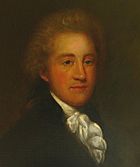
Thomas Cochrane was born in Annsfield, Scotland. His father was Archibald, Lord Cochrane, who later became the 9th Earl of Dundonald. His mother was Anna Gilchrist.
Thomas had six brothers. Two of them also served in the military with honor. His family had a long history of military service and Scottish nobility. However, by 1793, the family had lost their wealth. Their family estate was sold to pay off debts.
Cochrane spent much of his early life in Culross, Scotland. His uncle, Alexander Cochrane, helped him get listed as a crew member on Royal Navy ships when he was only five years old. This was a way for officers to gain years of service early. Cochrane preferred the Navy over the British Army. He joined the Navy in 1793 when the French Revolutionary Wars began. This was also when his family lost their money and lands.
Fighting in the French Revolutionary Wars
Cochrane joined the Navy as a midshipman on July 23, 1793, at age 17. He first served on the frigate HMS Hind with his uncle. He then moved to HMS Thetis, also under his uncle's command. He visited Norway and served in North America. In 1796, he became a lieutenant.
Later, he was assigned to HMS Barfleur in the Mediterranean. While on Barfleur, Cochrane had a disagreement with a superior officer. This showed a pattern of him not getting along with others, even those who should have been his friends.
In 1800, Cochrane became a commander and took charge of the brig sloop HMS Speedy. He had many clever escapes. Once, a Spanish warship almost caught him. He flew a Danish flag and pretended his ship had the plague to scare them away. Another time, he was being chased by an enemy frigate. He put a lantern on a barrel and let it float away. The enemy followed the light, and Speedy escaped!
In 1801, Cochrane fought a duel in Malta after an argument at a party. He was unharmed, but his opponent was wounded.
One of his most famous victories was capturing the Spanish frigate El Gamo on May 6, 1801. El Gamo had 32 guns and 319 men. Speedy had only 14 guns and 54 men. Cochrane sailed so close that El Gamos guns couldn't aim at Speedys hull. The Spanish tried to board, but Cochrane pulled away and fired on them. Finally, Cochrane boarded El Gamo and captured it, even though he was outnumbered six to one!
During Speedy's 13-month journey, Cochrane captured or destroyed 53 ships. On July 3, 1801, three French ships captured him. He was held as a prisoner, but the French admiral treated him very kindly. A few days later, he was exchanged. On August 8, 1801, he was promoted to post-captain.
Fighting in the Napoleonic Wars
After a short peace, war started again in 1803. Cochrane was given command of HMS Arab. He thought the ship was terrible. In 1804, he took command of the new frigate HMS Pallas. He had many successes, capturing Spanish merchant ships and a privateer.
In 1806, he commanded the frigate HMS Imperieuse. One of his midshipmen was Frederick Marryat, who later wrote adventure stories inspired by Cochrane.
In Imperieuse, Cochrane raided the French coast. In 1808, he and Spanish fighters captured a fortress that blocked a French army. This delayed the French for a month. He also copied French code books from a signal station, leaving the originals behind so the French wouldn't know. When his ship needed water, he sailed up the Rhone River. He also helped defend the town of Rosas against a French siege. He was one of the last men to leave the fort.
Cochrane was very good at coastal warfare. He attacked enemy bases and captured ships in harbors. He planned every operation carefully to keep his men safe and ensure success.
In 1809, Cochrane led an attack with fire ships on Rochefort. The attack caused much damage. However, Cochrane blamed the fleet commander for not destroying the French fleet completely. This led to a court-martial for the commander. Cochrane believed this made him unpopular with the navy leaders.
Political Life
In 1806, Lord Cochrane became a member of the House of Commons. He wanted to change Parliament and make it fairer. He first ran in Honiton and lost, but then won in October 1806. He later said he paid a small amount to voters, which was common then.
In 1807, he was elected by Westminster, which had a more democratic election. He spoke out against corruption in the navy and the government. This made him powerful enemies.
In 1810, Cochrane tried to help his political friend, Sir Francis Burdett, who was resisting arrest. Cochrane wanted to use naval tactics, which would have caused a lot of damage. Burdett stopped him.
Cochrane was popular with the public, but he struggled to get along with other politicians. He usually didn't succeed in his political goals.
In 1814, he was removed from Parliament due to a major event. However, his voters in Westminster re-elected him just 11 days later! He held this seat until 1818. In 1818, his last speech in Parliament was about making Parliament fairer.
In 1831, his father died, and Cochrane became the 10th Earl of Dundonald. This meant he could no longer sit in the House of Commons.
A Difficult Time: The Stock Exchange Event
In February 1814, rumors spread that Napoleon had died. This caused stock prices to rise sharply. It turned out to be a trick. An investigation found that six men had sold a lot of stock during this time. Cochrane was named as one of them, along with his uncle.
A man who claimed to be a military officer, but was actually an imposter, was seen entering Cochrane's house on the day of the trick. Cochrane said the man visited to ask for passage on his ship and was wearing a green uniform. Witnesses for the prosecution said the man wore a red uniform, like the one used in the trick.
Cochrane was put on trial. The judge was known to be against radical politicians like Cochrane. The jury found all the accused guilty. Cochrane was sentenced to 12 months in prison and fined £1,000. He was also removed from the Royal Navy and expelled from Parliament. His knighthood was taken away in a special ceremony.
However, the public was very upset. Cochrane was re-elected by his voters in Westminster. His punishment of standing in a pillory (a public display of shame) was canceled because people feared it would cause a riot.
Cochrane always said he was innocent. Many historians still debate whether he was truly guilty. Later reviews by important legal figures suggested he should have been found not guilty. Cochrane believed the trial was politically motivated.
He worked hard to clear his name. In 1832, a new King, William IV, who had served in the Navy, was sympathetic. Cochrane was granted a pardon and returned to the Navy as a rear-admiral. In 1847, Queen Victoria restored his knighthood. His banner, which had been removed from Westminster Abbey, was returned the day before his funeral in 1860.
In 1876, his grandson received £40,000 from the British government as compensation. A parliamentary committee had decided that Cochrane's conviction was unfair.
Marriage and Family Life
In 1812, Cochrane married Katherine ("Katy") Frances Corbet Barnes. She was about 20 years younger than him. They married in a civil ceremony because his wealthy uncle did not approve. His uncle then removed Cochrane from his will. Cochrane called Katherine "Kate," "Kitty," or "Mouse." She often traveled with him on his long trips.
They had six children. The confusion about their multiple marriage ceremonies led to questions about their first son's legitimacy. This delayed his son's right to become the Earl of Dundonald after Cochrane's death.
In 1823, Lady Cochrane and their children sailed to Valparaiso to join him. She later found him in Rio de Janeiro, where he was commanding the Brazilian Navy.
Later in life, Cochrane and Katherine separated in 1839. She moved to France and received money from him. She died in 1865.
Serving Chile
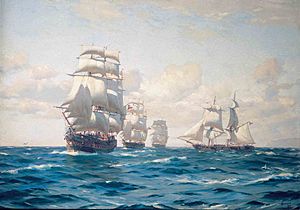
Even though he was disgraced in the UK, Lord Cochrane's naval career was not over. In 1817, he announced he was available to help newly independent nations. In 1818, a representative from General José de San Martín convinced him to join Chile's fight for independence.
Cochrane arrived in Valparaíso in November 1818 with his family. Chile was building its new navy to fight Spain. He became a Chilean citizen and was made Vice Admiral. He took command of the Chilean Navy. He reorganized the navy, using British customs and English as the official language on warships.
He blockaded and raided the coasts of Peru, just as he had done in Europe. He also bravely led the capture of Valdivia, a Spanish fortress, with only 300 men and two ships against seven large forts.
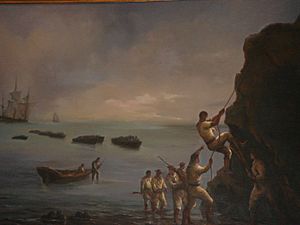
In 1820, he helped transport General San Martín's army to Peru. He blockaded the coast and supported Peru's independence. His forces also captured the powerful Spanish frigate Esmeralda. These victories helped Peru gain independence.
Cochrane's victories in the Pacific were amazing. However, he soon started arguing about pay and prize money. He also accused his superiors of plotting against him. He had a difficult relationship with San Martín, who called him El Metálico Lord (The Metallic Lord) because of his interest in money.
Cochrane left the Chilean Navy on November 29, 1822.
Chilean Ships Named After Cochrane
The Chilean Navy has honored Cochrane by naming five ships after him:
- The first, Almirante Cochrane, fought in the War of the Pacific (1879–1884).
- The second Almirante Cochrane was a large battleship. The Royal Navy bought it in 1917 and turned it into an aircraft carrier.
- The third ship, Cochrane, was a destroyer from the US Navy.
- The fourth ship, Almirante Cochrane, was a British destroyer.
- The fifth and current ship, Almirante Cochrane (FF-05), is a modern frigate.
Serving Brazil
Brazil was also fighting for independence from Portugal. In 1822, most southern provinces were controlled by the Brazilians. But Portugal still held important cities in the north.
Lord Cochrane took command of the Imperial Brazilian Navy on March 21, 1823. He was named "First Admiral." He blockaded the Portuguese in Bahia and fought them in the Battle of 4 May. He forced them to leave the province in a large group of ships, which Cochrane's men attacked.
Cochrane then sailed to Maranhão. He tricked the Portuguese soldiers there into surrendering. He claimed a huge Brazilian fleet and army were coming, even though they weren't! He sent another officer to do the same in Belém do Pará. Thanks to Cochrane, Brazil became completely independent from Portugal.
When he returned to Rio de Janeiro in 1824, Emperor Pedro I gave him the title of Marquess of Maranhão. But just like in Chile, Cochrane soon started arguing about pay and prize money. He also accused Brazilian officials of plotting against him.
In 1824, Cochrane sailed north to help stop a rebellion. After the rebellion was put down, he took control of the administration in Maranhão. He demanded prize money and took public money. He also attacked merchant ships. He then left Brazil and returned to Britain in June 1825.
Serving Greece
In August 1825, Greece hired Cochrane to help them fight for independence from the Ottoman Empire. He was active in the war from March 1827 to December 1828. However, he had limited success. His actions indirectly led to Britain, France, and Russia getting involved. These countries destroyed the Turkish-Egyptian fleet, which helped end the war. Cochrane resigned his position and returned to Britain.
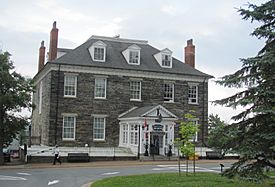
After his father died in 1831, Lord Cochrane became the 10th Earl of Dundonald. He was officially returned to the Royal Navy list in 1832 as a Rear-Admiral of the Blue. He refused to take command until his knighthood was restored, which took 15 years. He continued to be promoted through the ranks of admirals.
On May 22, 1847, Queen Victoria restored his knighthood. He returned to active duty in the Royal Navy. From 1848 to 1851, he served as Commander-in-Chief of the North America and West Indies Station. During the Crimean War, the government thought about giving him a command, but they worried he might take too many risks. In 1854, he was given the honorary title of Rear-Admiral of the United Kingdom.
In his final years, Lord Dundonald wrote his autobiography. He had two surgeries for kidney stones in 1860. He died during the second operation on October 31, 1860, in Kensington.
Dundonald was buried in Westminster Abbey. Every May, representatives from the Chilean Navy place a wreath at his grave.
New Ideas and Inventions
Cochrane was always thinking of new ways to do things. In 1805, he won a Royal Navy competition for a better convoy lamp by entering under a different name.
In 1806, he designed a special galley (a type of boat) that he carried on his ship. He used it to attack the French coast. It was very fast and flexible.
In 1812, Lord Cochrane suggested new ways to attack the French coast. This included using "stink vessels" (gas warfare), but his ideas were not used. He proposed them again during the Crimean War, but the authorities still did not use them.
In 1818, Cochrane patented the tunnelling shield with engineer Marc Isambard Brunel. This invention was used to build the Thames Tunnel in London.
He also supported steamships early on. He tried to bring a steamship to Chile for their war of independence, but it wasn't ready in time. He also faced delays with a steamship for the Greek War of Independence. In the 1830s, he experimented with steam power, developing a new engine and propeller. In 1851, he received a patent for powering steamships with bitumen.
Burial and Memorials
Lord Dundonald was buried in Westminster Abbey. His grave is in the middle of the nave. Each year in May, members of the Chilean Navy place a wreath there.
At his funeral, the Brazilian Minister in London said: "We place these flowers on Lord Cochrane's grave in the name of the Brazilian Navy, which he created, and of the Brazilian nation, to whose independence and unity he rendered incomparable services."
His epitaph, a message on his grave, describes him as a hero who used his "confidence and genius" and "extraordinary daring" to help his own country, Greece, Brazil, Chile, and Peru. It says he achieved a name famous worldwide for "courage, patriotism and chivalry."
Images for kids
-
Tribute of respect to the memory of Admiral Lord Cochrane by Brazilian naval officers (1901). His Grandson; Douglas Cochrane, 12th Earl of Dundonald is pictured 4th from the right.
-
Bust of Admiral Lord Dundonald (previously known as Lord Cochrane), in Culross, by Scott Sutherland; originally commissioned for HMS Cochrane shore base.
-
Memorial to Lord Dundonald in Valparaiso, Chile.
Coat of Arms
-
Earl of Dundonald's Coat of arms.
See Also
 In Spanish: Thomas Cochrane para niños
In Spanish: Thomas Cochrane para niños
- John Dundas Cochrane, his cousin.
- Admiral Sir Alexander Forrester Inglis Cochrane, his uncle.
- Sir Thomas John Cochrane, Vice-Admiral of the United Kingdom and Governor of Newfoundland, his cousin.
- Notable Royal Navy Officers of the Napoleonic Wars




